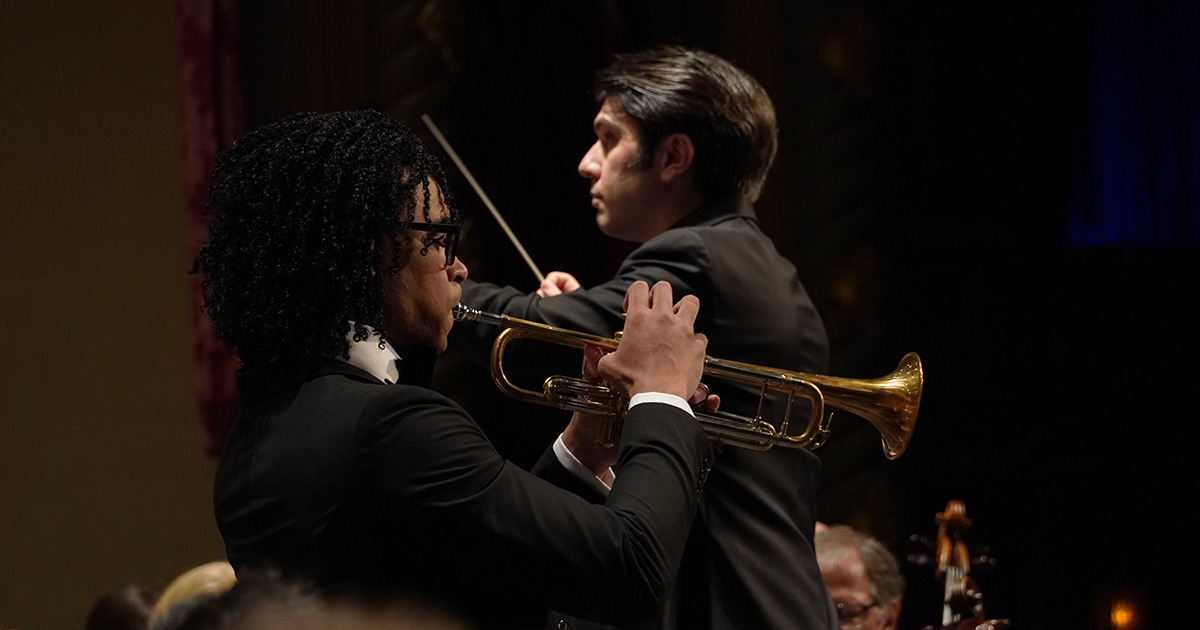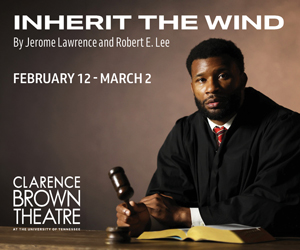A sip of cold champagne, a trumpet fanfare, and an energetic welcome from Maestro Aram Demirjian greeted audience arrivals at the Knoxville Symphony Orchestra’s opening Masterworks concerts this past weekend. While similar to previous versions of the KSO’s opening night festivities, the trumpet fanfare was especially appropriate on this occasion for it foreshadowed a sub-theme for the evening—the trumpet. More than just music for that instrument, the evening’s title—“Pictures at an Exhibition”—carried an undercurrent of expectation that suggested an incredibly varied and intriguing 2023-24 season to come. As arrivals found their seats in the theatre, a visual fanfare, of sorts, also greeted them via a projection screen over the stage that carried information on each of the individual Masterworks programs that follow. If this masterfully performed concert was any indication, demand and expectations will run high.
That projection screen, though, was mostly intended for the opening work on the program, Adam Schoenberg’s Picture Studies. The work was commissioned by the Kansas City Symphony, premiered in 2013, and was the composer’s modern approach based on the structural concept of Mussorgsky’s Pictures at an Exhibition. Based on paintings, photographs, and sculptures in the Nelson-Atkins Museum of Art in Kansas City, Schoenberg’s work follows the idea of 10 sections—like the Mussorgsky/Ravel work—but leaves Russian romanticism far behind. Instead, this deeply satisfying piece echoes novel orchestral lyricism, colors, and textures that ooze suggestions of American musical idioms and the American existence.
At roughly 25 minutes, Picture Studies was not your typical concert opener, but Demirjian took advantage of the work’s textural variations to keep the contrasting episodes interesting and fresh. With tonal punctuation and flavor of great importance, the performance was a veritable feast for the KSO percussion section, with plenty of nourishment left over for strings, woodwinds, and brass. In terms of that punctuation and flavor, clarinetist Victor Chavez offered a marvelous solo in “Miró” from the front balcony.
Next, the trumpet was the featured instrument in Armenian composer Alexander Arutiunian’s Trumpet Concerto from 1950—in a performance that showcased Canadian-born William Leathers as guest soloist. Leathers is the Principal Trumpet with the Nashville Symphony and received undergraduate and graduate degrees from the Juilliard School.
The concerto, thru-composed in multiple sections, has become a frequent audition piece for trumpeters because of its demands for beautiful tone and speed, with rapid-tonguing passages contrasting with smooth, golden lyricism. Leathers possesses a beautiful tone and the obvious ability to master impressive virtuosic technique without sacrificing subtleties and details.
After intermission, Demirjian and the orchestra launched into Mussorgsky’s Pictures at an Exhibition as orchestrated by Maurice Ravel. The “…as orchestrated by…” part is really quite essential in describing the work, for Ravel moves the tonal description of the paintings into a realm that Mussorgsky’s piano work can only begin to touch. As a whole and as parts, this was a marvelously solid and tightly rendered performance with sculpted snap, boom, and velvet moved along by chosen tempos that pushed and pulled at the listener.
And, again the trumpet shall sound. Trumpet Brian Winegardner captured the intricacies of “Samuel Goldenberg und Schmuyle” with marvelous agility. In “Gnomes,” the halting to and fro clumsiness was deliciously creepy, although I must blame The Big Lebowski for having cemented the movement in our brains. In the “Ballet of the Chickens in Their Shells,” the winds flurried furiously with a great deal of energy and fancy. Tubist Alexander Lapins had a nicely ponderous say in “Bydlo,” while saxophonist Allison Adams offered up a hauntingly melancholy rendering in “The Old Castle.” Kudos to all the brass for the necessary contrasts of majesty and power (“The Great Gate of Kiev”) and solemnity (“The Catacombs”) throughout.
Of course, “The Great Gate of Kiev” is the quintessential triumphant ending that rips the audience out of their seats and on to their feet. And, by my estimation, “triumphant” is a great way to start a season.






